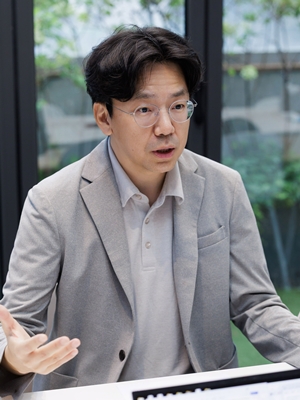- "Fosamax's value in osteoporosis sequential therapy rises"
- by Hwang, byoung woo | translator Hong, Ji Yeon | Nov 6, 2025 06:32am
During this process, the bisphosphonate class of drugs, demonstrating long-term evidence and sustained efficacy, is once again becoming the key treatment strategy.
DailyPharm met with Professor Beom-jun Kim of the Department of Endocrinology and Metabolism at Seoul Asan Hospital, to discuss the changing landscape and future challenges of osteoporosis treatment.
"Osteoporosis cases is increasing...prevention before fracture is crucial"

In particular, the rise in osteoporosis cases in South Korea is attributed to rapid aging and increased diagnosis rates.
Professor Kim explained, "As the elderly population rapidly increased, government attention rose, and this year, osteoporosis screening in general health check-ups was expanded to include women aged 60 and older," and added, "With early prevention and diagnosis underway, the number of patients is also increasing."
Osteoporosis is a disease characterized by porous bones. Since it typically presents no specific symptoms before a fracture occurs, it is easily overlooked by both patients and physicians.
However, as bone strength naturally declines by about 2% annually with age, the risk of fracture increases. Therefore, continuous management is emphasized, treating osteoporosis as a chronic disease requiring lifelong care, similar to hypertension or hyperlipidemia.
He stated, "Spinal and hip fractures not only severely diminish the quality of life due to pain, deformity, and mobility impairment, but hip fractures, in particular, carry a mortality rate of about 20%. Preventing fractures before they occur is particularly important, more so than treating them after one."
"Fosamax, a drug with 30 years of evidence...sustained efficacy of oral therapy is gaining attention"
To effectively treat osteoporosis, it is essential first to evaluate the patient's fracture risk and prescribe the appropriate medication.
According to Professor Kim, various factors are considered, including bone mineral density (BMD), T-score, age, weight, current medications, and family history. Generally, patients with a T-score below -2.5 are diagnosed with osteoporosis and categorized as high-risk for fracture. Bisphosphonate agents, including Fosamax, are globally recommended as the first-line treatment for these patients.
The major bisphosphonate, Fosamax (alendronate sodium), celebrates its 30th anniversary this year since its U.S. FDA approval in 1995. It was introduced in Korea in 1998.
Professor Kim explained, "The fact that we are still talking about Fosamax after three decades indicates its reliability." He added, "Its preventive effect has been confirmed across various sites, including vertebrae, non-vertebrae, and hip, establishing it as a first-line treatment for high-risk patients in both domestic and international guidelines."
He also mentioned the unique advantage of Fosamax as a once-weekly oral drug in the osteoporosis treatment landscape, where injectable drugs are commonly used.
Professor Kim pointed out, "According to the Korean Society for Bone and Mineral Research fact sheet, only 73.9% of women and 66.7% of men maintain treatment for a full year after starting medication. For injectables, discontinuing treatment can rapidly increase the risk of multiple vertebral fractures."
He added, "In contrast, Fosamax is deposited in the bone and maintains its therapeutic effect for a certain period." He emphasized that this feature, where the fracture-prevention effect persists for a period even after discontinuation, is an advantage in the Korean context, where treatment persistence is often low.
"The last in sequential therapy...need to improve access for patients at ultra-high-risk"
Professor Kim stressed that the concept of sequential therapy is becoming crucial, as osteoporosis treatment is a long-term strategy rather than a short-term prescription.
He said, "Considering the 100-year lifespan, continuously using a single drug is impractical. Therefore, a strategy of sequentially using multiple treatments, similar to hypertension or diabetes, is necessary," And added, "While Fosamax is recommended as a first-line treatment, its advantage as a 'closer' in the context of sequential therapy is gaining attention."
Professor Kim also said, "In the 'finishing stage' after reaching the osteoporosis treatment goal, Fosamax has the advantage of maintaining its efficacy in the bone, preventing rapid deterioration of the patient's condition." He added, "Regardless of the initial drug used, treatment must ultimately conclude with a bisphosphonate agent. We believe Fosamax's role in sequential therapy will only grow as new drugs increase."
He also evaluated the expansion of reimbursement criteria for osteoporosis treatment last year as a meaningful change.
He said, "Previously, patients had to stop treatment coverage if their T-score went above -2.5, even if they wished to continue. Now, the maximum period for continued treatment has been extended up to two years, even at a T-score of -2.0, which is positive for securing treatment continuity."
Professor Kim pointed out the institutional need to lift restrictions on the treatment sequence for ultra-high-risk patients and advised against avoiding treatment due to concerns about adverse reactions.
Professor Kim said, "Globally, the recommended strategy is first to use bone formation promoters (anabolic agents) followed by anti-resorptive agents for maintenance. However, due to current domestic reimbursement criteria, we must apply this in reverse," and suggested, "The treatment sequence needs to be improved, at least for the ultra-high-risk group."
Finally, Professor Kim said, "Although fear of adverse reactions is one reason for hesitation, concerns like 'jawbone necrosis' are actually very rare," and added, "The incidence in South Korea is around 4 per 10,000 people (0.04%), while the risk of fracture is a thousand times higher. Avoiding treatment due to a rare risk is like not wearing a seatbelt."
-

- 0
댓글 운영방식은
댓글은 실명게재와 익명게재 방식이 있으며, 실명은 이름과 아이디가 노출됩니다. 익명은 필명으로 등록 가능하며, 대댓글은 익명으로 등록 가능합니다.
댓글 노출방식은
댓글 명예자문위원(팜-코니언-필기모양 아이콘)으로 위촉된 데일리팜 회원의 댓글은 ‘게시판형 보기’와 ’펼쳐보기형’ 리스트에서 항상 최상단에 노출됩니다. 새로운 댓글을 올리는 일반회원은 ‘게시판형’과 ‘펼쳐보기형’ 모두 팜코니언 회원이 쓴 댓글의 하단에 실시간 노출됩니다.
댓글의 삭제 기준은
다음의 경우 사전 통보없이 삭제하고 아이디 이용정지 또는 영구 가입제한이 될 수도 있습니다.
-
저작권·인격권 등 타인의 권리를 침해하는 경우
상용 프로그램의 등록과 게재, 배포를 안내하는 게시물
타인 또는 제3자의 저작권 및 기타 권리를 침해한 내용을 담은 게시물
-
근거 없는 비방·명예를 훼손하는 게시물
특정 이용자 및 개인에 대한 인신 공격적인 내용의 글 및 직접적인 욕설이 사용된 경우
특정 지역 및 종교간의 감정대립을 조장하는 내용
사실 확인이 안된 소문을 유포 시키는 경우
욕설과 비어, 속어를 담은 내용
정당법 및 공직선거법, 관계 법령에 저촉되는 경우(선관위 요청 시 즉시 삭제)
특정 지역이나 단체를 비하하는 경우
특정인의 명예를 훼손하여 해당인이 삭제를 요청하는 경우
특정인의 개인정보(주민등록번호, 전화, 상세주소 등)를 무단으로 게시하는 경우
타인의 ID 혹은 닉네임을 도용하는 경우
-
게시판 특성상 제한되는 내용
서비스 주제와 맞지 않는 내용의 글을 게재한 경우
동일 내용의 연속 게재 및 여러 기사에 중복 게재한 경우
부분적으로 변경하여 반복 게재하는 경우도 포함
제목과 관련 없는 내용의 게시물, 제목과 본문이 무관한 경우
돈벌기 및 직·간접 상업적 목적의 내용이 포함된 게시물
게시물 읽기 유도 등을 위해 내용과 무관한 제목을 사용한 경우
-
수사기관 등의 공식적인 요청이 있는 경우
-
기타사항
각 서비스의 필요성에 따라 미리 공지한 경우
기타 법률에 저촉되는 정보 게재를 목적으로 할 경우
기타 원만한 운영을 위해 운영자가 필요하다고 판단되는 내용
-
사실 관계 확인 후 삭제
저작권자로부터 허락받지 않은 내용을 무단 게재, 복제, 배포하는 경우
타인의 초상권을 침해하거나 개인정보를 유출하는 경우
당사에 제공한 이용자의 정보가 허위인 경우 (타인의 ID, 비밀번호 도용 등)
※이상의 내용중 일부 사항에 적용될 경우 이용약관 및 관련 법률에 의해 제재를 받으실 수도 있으며, 민·형사상 처벌을 받을 수도 있습니다.
※위에 명시되지 않은 내용이더라도 불법적인 내용으로 판단되거나 데일리팜 서비스에 바람직하지 않다고 판단되는 경우는 선 조치 이후 본 관리 기준을 수정 공시하겠습니다.
※기타 문의 사항은 데일리팜 운영자에게 연락주십시오. 메일 주소는 dailypharm@dailypharm.com입니다.









